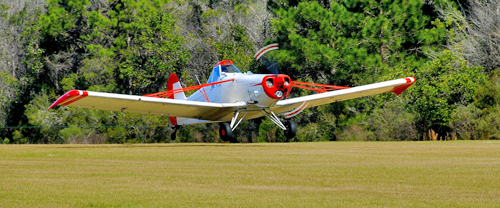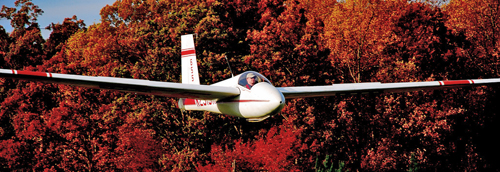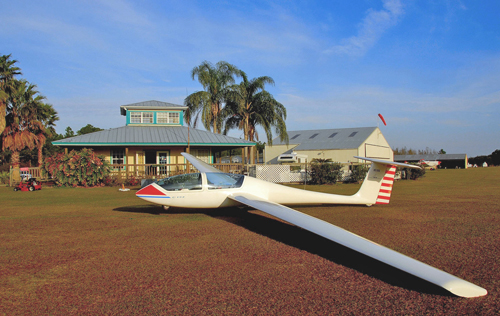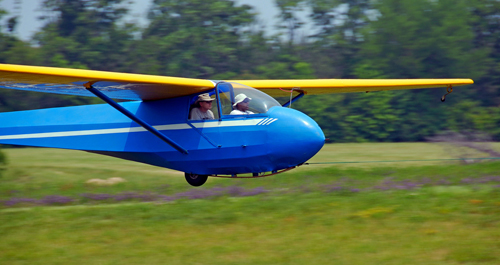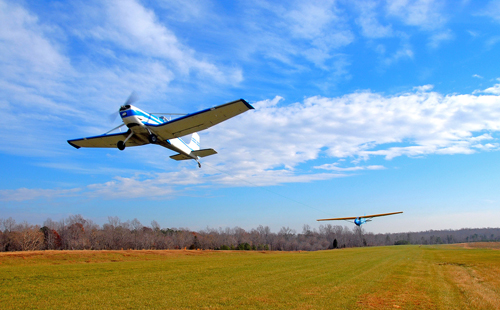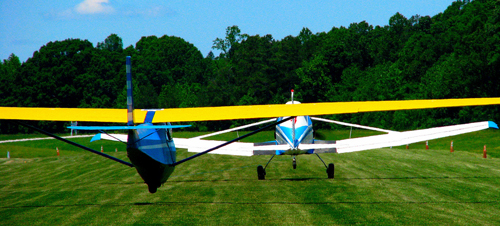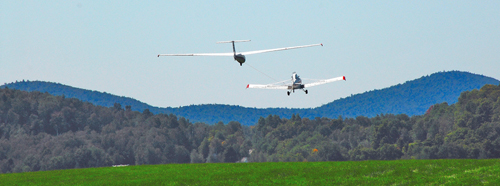This eFLYER was developed in HTML for viewing with Microsoft Internet Explorer while connected to the Internet: View Online.
To ensure delivery to your inbox, please add eFLYER@barnstormers.com to your address book or list of approved senders. |
 |
ISSUE
33 - September 2008
Over 7,000 Total Ads Listed
1,000 NEW Ads Per Week
|
| A YEAR OF SOARING |
By Michael
A. Likavec, Contributing Editor & Photographer
Chester, Virginia
|
|
| A Piper Pawnee tows a Blanik into the
afternoon sky at Seminole Lake Gliderport in Florida |
The wind
whispers past the wings and we steepen the bank to near
60 degrees. We are at 3000 feet and climbing at more than
300 feet per minute. The thermals are building with the
afternoon heat. Three hawks are circling with us in a thermal
just west of the airport. They don't seem to mind sharing
the sky and we admire their effortless ability to stay
in the lift. I wonder if their flight has purpose, or are
they, like us, just out to enjoy the view.
For the last year I have been frequenting a number of gliderports with two goals
in mind. I wanted to add a commercial glider rating to my ticket, and along the
way I have started something of a personal photo project, documenting this corner
of the aviation world, experienced by only a small percentage of general aviation
pilots. I visited with, photographed and piloted gliders at a number of places
during the year, mostly smaller, rural operations. The flying and photography
does not include dramatic mountain scenery and high performance fiberglass ships
you might see in a glossy magazine or on a calendar. This is a more intimate
view of weekend fliers, working to squeeze maximum performance out of older machines.
Pilots passing on their knowledge and experience to a new group of aviators.
The goal on any given day is to get a club member soloed, not set a world record;
to enjoy the day, the sky and the good company of fellow glider pilots.
The aircraft are not new or sleek. The venerable Schweizer 2-33 and the single
place S-1-26 appear often, as does the Blanik and the Lark IS-28. These ships
are towed aloft by aging ag planes that have found new life and purpose after
being retired from their original mission. There also seems to be a large number
of retired pilots in this group, no longer worrying about traffic delays and
weather, just wanting to stay active and in the air.
Come along and share a season of soaring by looking through my notebook and viewfinder.
Who knows, you may find it inspires you to find a glider, a thermal and some
excellent company along the way.
|
By the mid 1970's the U.S. market
for piston powered ag planes had come to an end. The backlash
against spraying pesticides, as well as the economic factors
brought production of these airplanes to a halt. Some of
these aircraft found their way to Central or South America,
many of the remaining ones have found homes as tow planes
for glider clubs or commercial operators. Piper Pawnees
and Cessna C-188 Agwagons are now found towing every type
of glider, with engines ranging from 235 to over 300 hp.
These retired sprayers soldier on, year after year, towing
glider pilots into the air looking for that elusive lift
that will keep them airborne for just a little longer.
This Piper Pawnee is used daily for towing at Seminole
Lake Gliderport.
|
Weighing in at only about 500 pounds,
the single place Schweizer 1-26 offers glider pilots solo
flight experience. Checkout is an extended ground briefing,
orientation, and a good luck wave. These small sailplanes
have a 26:1 glide ratio with a best L/D speed of 42 knots.
Seen here is a 1-26 operated by the Merlin Soaring Association
at Merlin Aerodrome, near Richmond, Virginia. |
Before you can begin soaring, you
have to get the glider in the air. Typically tows are to
3,000 feet unless otherwise arranged. Most operations in
the U.S. utilize aero tows rather than auto or winch launches.
Here the Lark IS-28 begins its climb behind the Cessna
Ag wagon. Liftoff takes only a few hundred feet with climb
to 3,000 feet taking about five or six minutes once airborne.
On a good day the short tow may result in a flight of several
hours. |
My soaring year started in September.
By January it was getting cold in Virginia. A daily high
of 30 degrees with 20 knots of northwest wind will send
even the most dedicated glider pilot indoors, or south.
In my case I chose a heading of about 200 degrees and ended
up at Seminole Lake Glider Port near Orlando, Florida.
Spending four days in the sun, with the daytime high averaging
better than 78 degrees, is a great way to recharge and
enjoy some soaring. The Grob 103 pictured here sits in
front of the Seminole Lake clubhouse/office. Limited RV
camping is available at Seminole Lake as well as rooms
in the Clubhouse. A 3000 foot grass strip and a great full-time
staff of instructors and tow pilots make this a good choice
for winter training or a getaway.
|
Just as the Cessna 150 was the primary
trainer for a generation of powered aircraft pilots, the
two place Schweizer 2-33 was the primary trainer for glider
pilots during the same time period. Like the C-150, the
2-33 continues on as a trainer and inexpensive club aircraft.
These tandem gliders have metal wings, fabric covered fuselage
and spoilers for glide path control. The 2-33 is neither
sleek nor particular pretty when put next to the modern
glass sailplanes but it remains a fun and inexpensive way
to get started in soaring. Both my first solo and checkride
were taken in the Schweizer. |
|
| Cessna C-188 Towing an S-2-33 |
Good tow pilots are critical to
the safe and successful operation of any glider operation,
be it a commercial operation or a club. Towing gliders
requires specific advanced training and a logbook endorsement.
A good tow pilot can make the ride to altitude a walk in
the park. This Cessna C-188 is towing an S-2-33 at Merlin
Aerodrome. Many glider pilots also qualify as tow pilots
and instructors so that they can do double duty at the
local club. |
Give me a sailplane and a grass
runway, a little thermal lift, and I can be happy all day.
In the early spring the grass turns thick and a lush green,
acting as a cushion for touchdowns, making my landings
feel better than they actually are. As the day heats up,
the grass is much more pleasant than a paved surface and
you can picnic right next to the touchdown zone, grading
the landings of your fellow glider pilots. Most gliderports
share the grass with at least some powered aircraft. I
have always found my powered flight brothers careful and
considerate in our shared space, perhaps they are thinking
about landing their craft without power and instinctively
yield to their long wing colleagues. |
Moving up from primary training
in the 2-33 to the Lark is a real eye opener in terms of
understanding glider performance. The much improved glide
ratio, increased weight, flaps and retractable gear remind
me of the transition from a Cessna 172 up to retractable
high performance powered craft. The spoilers which can
be seen here fully deployed for landing are extremely effective
allowing greater flexibility in the pattern.
|
By August central Virginia has become
hot and humid with the summer haze limiting visibility
and soaring fun. Time to head north and try out Sugar Bush
Soaring in Vermont. Soaring in different locations is a
great way to build your knowledge base, seeing how different
terrain impacts glider performance. The mountains surrounding
Sugar Bush require a different mindset than flying in the
relatively flat terrain of Virginia or Florida, but they
open great opportunities for ridge soaring and wave operations
which can lift gliders to 20,000 feet or more.
My brief mountain gliding experience brings me to the
end of my first year of soaring. I have added the commercial
glider rating I set out to acquire. I've had fun with this
personal photo project, but most of all I have made some
great friends along the way who have been generous beyond
belief in sharing their knowledge and experience with the
new guy at the field. My thanks to all the great pilots
I have had the honor to soar with during the last year.
Finally, thanks to the family of hawks that live somewhere
near Merlin Aerodrome who were so kind as to share the
lift with me in a thermal one summer afternoon. I will
long remember and treasure your company. |
|
| |
Visit www.barnstormers.com - post an ad to be viewed by over 500,000 visitors per month.
Over 12 years bringing more online buyers and sellers together than any other aviation marketplace. |
Copyright © 2008 All rights reserved.
 |
| UNSUBSCRIBE INSTRUCTIONS: If you no longer wish to receive this eFLYER, unsubscribe here or mail a written request to the attention of: eFLYER Editor BARNSTORMERS, INC. 312 West Fourth Street, Carson City, NV 89703. NOTE: If you registered for one or more hangar accounts on barnstormers.com, you must opt out of all of them so the eFLYER mailings will be fully discontinued. |
|




